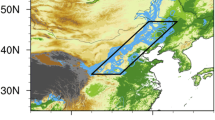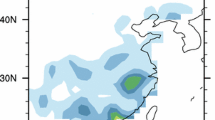Abstract
This study examines the active role of sea surface temperature (SST) over the Kuroshio Extension region during heavy rainfall events over the Korean Peninsula within Changma period (June–July). While the overall synoptic patterns during the heavy rainfall events over Korea are similar to those during moderate rainfall events (i.e. between 0.5 and 1 standard deviation), the synoptic signals preceding heavy rainfall events are distinct from those of moderate rainfall events. A distinguishing feature is the maintenance of a high-pressure anomaly over the Kuroshio Extension region, which lead to persistent southerly winds and resultant heavy rainfall events over the Korean Peninsula, from roughly 1 week before the start of heavy rainfall events. On the other hand, the high-pressure anomaly associated with the moderate rainfall events is propagated from the west along the climatological westerly winds. It was found that positive SST anomalies over the Kuroshio Extension region (140–156°E, 28–35°N) play an important role in maintaining the high-pressure anomaly over the Kuroshio Extension region. None of heavy rainfall events was found when the positive geopotential height anomaly over the Kuroshio Extension region was co-located with a local negative SST anomaly. This probability increased to 62% when the positive geopotential height anomaly was co-located with a local positive SST anomaly. This shows that a positive SST anomaly over the Kuroshio Extension region can be a useful precursor to heavy rainfall events over the Korean Peninsula.










Similar content being viewed by others
References
Cha, E.J., Kimoto, M., Lee, E.J., Jhun, J.G.: The recent increase in the heavy rainfall events in August over the Korean peninsula. J. Korean Earth Sci. Soc. 28(5), 585–597 (2007)
Cho, N.–.S., Lee, T.–.Y.: A numerical study of multiple convection bands over the Korean peninsula. J. Korean Meteor. Soc. 42(2), 87–105 (2006)
Ding, Q., Wang, B.: Circumglobal teleconnection in the northern hemisphere summer. J. Clim. 18(17), 3483–3505 (2005)
Ha, K.–.J., Park, S.–.K., Kim, K.–.Y.: Interannual variability in summer precipitation around the Korean peninsula and its associated east Asian summer circulation. Asia-Pac. J. Atmos. Sci. 39(5), 575–586 (2003) (In Korean)
Ham, Y.G., Na, H.Y.: Marginal sea surface temperature variation as a pre-cursor of heat waves over the Korean peninsula. Asia-Pac. J. Atmos. Sci. 53(4), 445–455 (2017)
Ho, C.-H., Kang, I.-S.: The variability of precipitation in Korea. J. Korean Meteor. Soc. 24, 38–48 (1988) (in Korean)
Holton, J. R., Hakim, G. J.: An Introduction to Dynamic Meteorology, Volume 88, Fifth Edition. Academic press, 552 pp (2012).
Hong, S.Y., Lee, J.W.: Assessment of the WRF model in reproducing a flash-flood heavy rainfall event over Korea. Atmos. Res. 93(4), 818–831 (2009)
Kelly, K.A., Small, R.J., Samelson, R.M., Qiu, B., Joyce, T.M., Kwon, Y.O., Cronin, M.F.: Western boundary currents and frontal air-sea interaction: gulf stream and Kuroshio extension. J. Clim. 23(21), 5644–5667 (2010)
Kim, J.S., Li, R.C.Y., Zhou, W.: Effects of the Pacific-Japan teleconnection pattern on tropical cyclone activity and extreme precipitation events over the Korean peninsula. J. Geophys. Res.-Atmos. 117(D18), (2012)
Kosaka, Y., Nakamura, H.: Mechanisms of meridional teleconnection observed between a summer monsoon system and a subtropical anticyclone. Part I: the Pacific–Japan pattern. J. Clim. 23(19), 5085–5108 (2010)
Kuwano-Yoshida, A., Minobe, S., Xie, S.P.: Precipitation response to the Gulf stream in an atmospheric GCM*. J. Clim. 23(13), 3676–3698 (2010)
Kwon, Y.O., Alexander, M.A., Bond, N.A., Frankignoul, C., Nakamura, H., Qiu, B., Thompson, L.A.: Role of the Gulf stream and Kuroshio-Oyashio systems in large-scale atmosphere-ocean interaction: a review. J. Clim. 23(12), 3249–3281 (2010)
Lee, D.-K., Hong, S.-Y.: Numerical experiment of the heavy rainfall event occurred over Korea during 1–3 September 1984. J. Korean Meteorol. Soc. 25, 233–260 (1989)
Lee, T.-Y., Park, Y.-Y., Kim, Y.-H.: A numerical modeling study of heavy rainfall development over the Changma front. Proceedings of the International Conference on Monsoon and Hydrologic Cycle, April 22–25, 1998, Kyongju, Korea, 72–75 (1998)
Lee, E.J., Yeh, S.W., Jhun, J.G., Moon, B.K.: Seasonal change in anomalous WNPSH associated with the strong east Asian summer monsoon. Geophys. Res. Lett. 33(21), (2006)
Lee, J.Y., Kwon, M., Yun, K.S., Min, S.K., Park, I.H., Ham, Y.G., et al.: The long-term variability of Changma in the east Asian summer monsoon system: a review and revisit. Asia-Pac. J. Atmos. Sci. 53(2), 257–272 (2017)
Minobe, S., Kuwano-Yoshida, A., Komori, N., Xie, S.P., Small, R.J.: Influence of the Gulf stream on the troposphere. Nature. 452(7184), 206–209 (2008)
Minobe, S., Miyashita, M., Kuwano-Yoshida, A., Tokinaga, H., Xie, S.P.: Atmospheric response to the gulf stream: seasonal variations*. J. Clim. 23(13), 3699–3719 (2010)
Miyazawa, Y., Kagimoto, T., Guo, X., Sakuma, H.: The Kuroshio large meander formation in 2004 analyzed by an eddy-resolving ocean forecast system, J. Geophys. Res. 113, C10015 (2008). https://doi.org/10.1029/2007JC004226.
Miyazawa, Y., Zhang, R., Guo, X., Tamura, H., Ambe, D., Lee, J.-S., et al.: Water mass variability in the western North Pacific detected in a 15-year eddy resolving ocean reanalysis, J. Oceanogr. 65, 737–756 (2009)
Nakamura, H., Wallace, J.M.: Synoptic behavior of baroclinic eddies during the blocking onset. Mon. Weather Rev. 121(7), 1892–1903 (1993)
Park, S.-U., Yoon, I.-H., Chung, S.-K.: Heat and moisture sources associated with Changma front during the summer of 1978. J. Korean Meteor. Soc. 22, 1–27 (1986)
Park, H.-L., Seo, K.-H., Son, J.-H.: Development of dynamics-based statistical prediction model for the Changma onset. J. Clim. 28, 6647–6666 (2015). https://doi.org/10.1175/JCLI-D-14-00502.1
Park, S., Kim, D.J., Lee, S.W., Lee, K.W., Kim, J., Song, E.J., Seo, K.H.: Comparison of extended medium-range forecast skill between KMA ensemble, ocean coupled ensemble, and GloSea5. Asia-Pac. J. Atmos. Sci. 53(3), 393–401 (2017)
Seo, K.-H., Son, J.-H., Lee, J.-Y.: A new look at Changma. Atmosphere. 21, 109–121 (2011) (In Korean)
Shapiro, M.A.: Frontogenesis and geostrophically forced secondary circulations in the vicinity of jet stream-frontal zone systems. J. Atmos. Sci. 38(5), 954–973 (1981)
Shin, C.-S., Lee, T.-Y.: Development mechanisms for the heavy rainfall of 6-7 August 2002 over the middle of the Korean peninsula. J. Meteor. Soc. Japan. 83, 683–709 (2005)
Small, R.J., Xie, S.P., O’Neill, L., Seo, H., Song, Q., Cornillon, P., et al.: Air–sea interaction over ocean fronts and eddies. Dyn. Atmos. Oceans. 45(3), 274–319 (2008)
Sun, J., Lee, T.Y.: A numerical study of an intense quasi-stationary convection band over the Korean peninsula. J. Meteorol. Soc. Japan. 80, 1221–1245 (2002)
Tokinaga, H., Tanimoto, Y., Xie, S.P., Sampe, T., Tomita, H., Ichikawa, H.: Ocean frontal effects on the vertical development of clouds over the western North Pacific: in situ and satellite observations*. J. Clim. 22(16), 4241–4260 (2009)
Xu, H., Xu, M., Xie, S.P., Wang, Y.: Deep atmospheric response to the spring Kuroshio over the East China Sea*. J. Clim. 24(18), 4959–4972 (2011)
Zhao, C., Li, T., Yao, S., Behera, S.K., Nasuno, T.: Intraseasonal variability of air temperature over East Asia in boreal summer. Front. Earth Sci. 5, 63 (2017)
Acknowledgements
This work was funded by the Korea Meteorological Administration Research and Development Program under grant KMI2018-07010. Y.-G. Ham was supported by Basic Science Research Program through the National Research Foundation of Korea (NRF) funded by the Ministry of Education (NRF-2016R1A6A1A03012647).
Author information
Authors and Affiliations
Corresponding author
Additional information
Responsible editor: Sang-Wook Yeh
Rights and permissions
About this article
Cite this article
Ham, YG., Na, HY. & Oh, SH. Role of Sea Surface Temperature over the Kuroshio Extension Region on Heavy Rainfall Events over the Korean Peninsula. Asia-Pacific J Atmos Sci 55, 19–29 (2019). https://doi.org/10.1007/s13143-018-0061-8
Received:
Revised:
Accepted:
Published:
Issue Date:
DOI: https://doi.org/10.1007/s13143-018-0061-8




